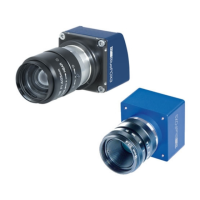12.14 LUT Control
The "LUT Control" contains features like
Feature name (acc. to SFNC)
Property name
(acc. to
mvIMPACT
Acquire)
Description
LUTSelector LUTSelector Selects which LUT to control.
LUTEnable[LUTSelector] LUTEnable Activates the selected LUT.
LUTIndex[LUTSelector] LUTIndex
Control the index (offset) of the coefficient
to access in the selected LUT.
LUTValue[LUTSelector][LUTIndex] LUTValue
Returns the Value at entry LUTIndex of
the LUT selected by LUTSelector.
LUTValueAll[LUTSelector] LUTValueAll
Allows access to all the LUT coefficients
with a single read/write operation.
mvLUTType
Describes which type of LUT is used for
the current LUTSelector
mvLUTInputData
Describes the data the LUT is applied to
(e.g bayer, RGB, or gray data)
mvLUTMapping
Describes the LUT mapping (e.g. 10 bit
-> 12 bit)
related to the look-up table (LUT) control.
The look-up table (LUT) is a part of the signal path in the camera and maps data of the ADC into
signal values. The LUT can be used e.g. for:
High precision gamma•
Non linear enhancement (e.g. S-Shaped)•
Inversion (default)•
Negative offset•
Threshold•
Level windows•
Binarization•
This saves (approx. 5%) CPU load, works on the fly in the FPGA of camera, is less noisy and there
are no missing codes after Gamma stretching. Three read-only registers describe the LUT that is
selected using the LUTSelector register:
12.14.1 mvLUTType
There are two different types of LUTs available in MATRIX VISION cameras: Direct LUTs define a
mapping for each possible input value, for example a 12 -> 10 bit direct LUT has 2^12 entries and
each entry has 10 bit. Interpolated LUTs do not define a mapping for every possible input value,
instead the user defines an output value for equidistant nodes. In between the nodes linear
interpolation is used to calculate the correct output value. Considering a 10 -> 10 bit interpolated
LUT with 256 nodes (as usually used in MATRIX VISION cameras), the user defines a 10 bit output
value for 256 equidistant nodes beginning at input value 0, 4, 8, 12, 16 and so on. For input values
12 GenICam and Advanced Features
114

